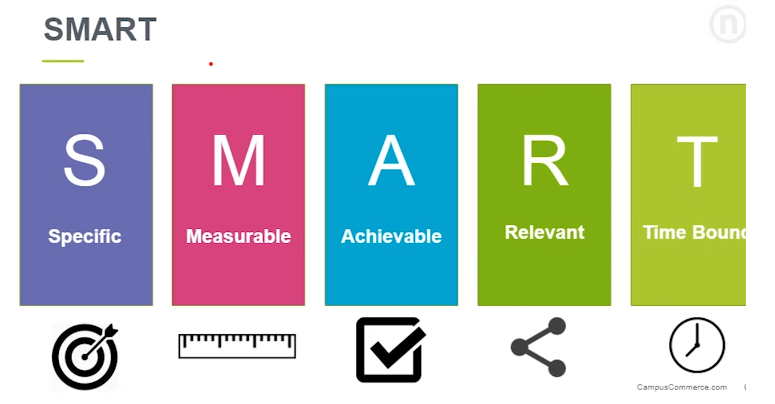Using SMART to Set your Goals in 2022
In Brief:
-
The start of a new year is a perfect time to set goals. A new goal could be something personal, like wanting to read more, to something professional, like wanting get better at networking.
-
No matter how big the goal, the hardest part is getting started. Using SMART goals will give you a foundation of success that is clear and achievable as you plan out your goals for the year.
Blog Post
SMART Goals and How to Use Them
Allison Gemelke, Senior Corporate Trainer from Nelnet University, hosted a professional development webinar back in 2021 that is still very relevant as we start a new year, Think SMART, to walk participants through how to set up a SMART goal. SMART is an acronym (Specific, Measurable, Achievable, Relevant, Time bound) with each letter representing a step of setting your goal. According to Allison, when setting a goal, you are more likely to achieve it with specifics so you know exactly what it is that you want to accomplish.

- Specific (simple, sensible, significant)
- Measurable (meaningful, motivating)
- Achievable (agreed, attainable)
- Relevant (reasonable, realistic and resourced, results-based)
- Time bound (time-based, time limited, time/cost limited, timely, time-sensitive)
Each of the SMART components is needed in order for your goal to have clarity and focus. Clarity and focus are the driving force behind achieving your goal. Without clarity you wouldn’t know what to do; without focus, you wouldn’t have a reason to do it.
S: Specific
SMART goals start with specific. By being specific in your goal, you can see what you need to do and the correct actions to take. When you start, ask yourself a series of questions about the goal, like “What do I mean by this goal?” or “How would that help me achieve this goal?” By asking question about your goal, you can drill-down to what’s important. Allison says, “Often times, a lack of specificity is the largest reason people don’t accomplish their goals.”
M: Measurable
Once the specifics of your goal is defined, it’s time to measure it. Making your goal measurable, gives it clarity. Having clarity on measurement can help you focus on what you need to do to get to your goal. Visualizing your action – which is what you’re measuring – gives you focus if you start to feel your goal is unreachable. When setting goals as a team or department having a measurement helps to ensure everyone is seeing success in the same way. Your team will know when they have achieved success when they have hit the agreed upon measurement.
A: Achievable
Achievable comes next and is where you ask yourself if you can achieve your goal. It can be tricky to identify the achievability of your goal. While your goal may be specific and measurable, it still may be hard to achieve. It’s here you ask yourself questions like, “What could prevent me from completing this goal?” and “What parts of my goal are out of my control?” When thinking about achievability, this step can result in your goal changing. If necessary, you may need to go back to a previous section and rewrite it. “There is no value in creating goals you can’t achieve,” Allison explains.
R: Relevant
When you find your goal is achievable, you need to ask yourself if it’s relevant. Relevant is the ‘R’ in SMART and isn’t about whether or not you should do something, it’s about recognizing the value of your time, budget, and resources, and realizing these are limited. Ask yourself, “What does accomplishing this goal do for me?” and “Why should I do it?” Then ask yourself, “What can I not do as a result of investing time and resources into this goal?” There’s a tradeoff when you invest your limited resources, so take some time to reflect on what you cannot do as a result of investing your resources into this goal. This can help you identify what is most important and bring you to the right, relevant things.
T: Time bound
After you have established the relevancy of your goal, you need to set time boundaries. Time bound, the final component of the acronym, is when you set a time boundary, however vague, to achieve your goal by. By setting a time boundary, it can motivate you and help you answer the achievability component of your goal, like “Can I really read three books in a week?” Without specific time boundaries, you may be far less likely to succeed. “Most people do better with a deadline,” says Allison. When setting time boundaries, ask yourself, “When will I complete this?” and “What is the timeline for each step?” As you go through your time boundaries, you may need to adjust your goals – and that’s okay!
Moving forward with SMART
Once you have completed writing your SMART goal, look at the first goal you wrote down and look at the final goal you created. Of these two goals, see which one seems more likely for you to accomplish. Your final goal should be specific, measurable, achievable, relevant, and time bound. If you hit a roadblock in your goal, do not abandon it. Adjust your timeline and expectations and keep moving forward. By setting up your goals using the SMART method, you will continue to move towards success.

Author: Jeralee Hahn
Jeralee Hahn is the Director of Marketing for Nelnet Campus Commerce. Working in the payments industry for the last six years, she has experienced the changing world of payment technology and various uses that students and faculty need on a higher education campus. Jeralee believes that communication is key to all successes in business and life and strives for this excellence from herself and Nelnet Campus Commerce. When she's not working, she enjoys being a mom to two kiddos, running and enjoying the outdoors in Nebraska.
